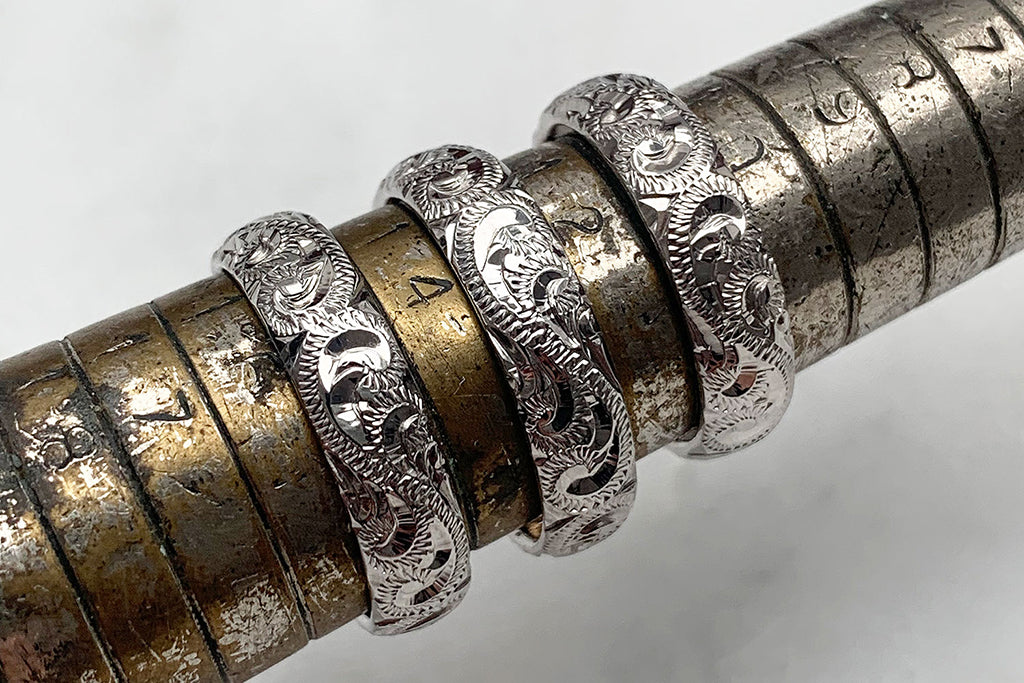Your Cart is Empty
Perhaps you have recently become the proud new owner of an engagement ring (congratulations!), have stumbled upon a family heirloom amidst some old belongings, or have found the perfect vintage engagement ring for your partner whilst shopping around. Understandably, you might want to know, for certain, that the jewel in question is legitimate. Thankfully, diamonds and precious metals bear measurable characteristics that enable us to ascertain their authenticity.
 A trio of bespoke friendship rings, created using 18ct white gold repurposed from a family heirloom ring
A trio of bespoke friendship rings, created using 18ct white gold repurposed from a family heirloom ringWe’re all familiar with the incriminating green marks left behind by a deceitful piece of jewellery purporting to be silver or gold, but sometimes the signs aren’t quite so apparent. For the more mysterious of jewels, there are a number of metal-testing methods.
Wondering how to tell whether your ring's band is the real deal? Place it in a glass of water. Real gold and platinum, classified as ‘heavy metals’ (i.e. metals denser than water), will sink straight to the bottom. If your ring rises to the surface, hovers around somewhere in the middle or even falters in its sinking process, it’s definitely not solid gold or platinum. The high density of gold and platinum also lends a weightiness that is palpable; any ring cast in these metals should feel solid on the finger, and noticeably heavier in the hand than silver or non-precious metals.
Depending on the metal type, age and nationality of your ring, you might also be able to find some hallmarks. A hallmark is a small stamp, branded into a piece of jewellery to verify the percentage of precious metal present. In many countries, it’s a legal requirement. In the modern-day context, a British-manufactured ring should bear at least three marks: the sponsor’s mark, the standard mark, and the mark identifying which of the four UK Assay Offices branded it.

If you’re still unsure, professional metal-testing services are easy to find via a quick Google search.
 A bespoke solitaire engagement ring, set with a refurbished 2.39ct diamond, originally taken from a family heirloom ring
A bespoke solitaire engagement ring, set with a refurbished 2.39ct diamond, originally taken from a family heirloom ringThere’s no doubt about it; in the context of an engagement ring, its gemstone is the star of the show. Understandably, it’s probably the aspect whose authenticity you’re most concerned with. Counterfeit diamonds are growing more believable by the year. Even the time-honoured scratch test, whereby a diamond’s authenticity is assessed by its ability to scratch a plate of glass, can now be overruled by a high quality fake.
Thankfully, there remain a few low-tech tests that you can try out at home to decipher whether your diamond is authentic with a small degree of certainty.
Firstly, diamonds are excellent heat conductors, so when breathing directly onto a diamond like you’d fog a mirror or window, you should notice that the mist clears almost instantly. It’s worth bearing in mind, however, that moissanite – a naturally occurring silicone carbide that presents similarly to a diamond – also passes this test. Diamond pens - electronic probes that test the heat conducting ability of any given diamond or gemstone – offer slightly more dependable results to this approach, but even these tools can be confused by high-quality moissanite stones in some cases.
Alternatively, you could compare the weight of your diamond to a known cubic zirconia of the same size. (If you happen to come by one, that is!) Cubic zirconia is actually far denser than diamond, so you should feel in your hand – or see on the scales – that the known cubic zirconia is almost 50% heavier.
For absolute certainty, no approach is more reliable than asking a trained gemmologist to inspect the gemstone through a loupe.
 Our client's inherited Art Deco cocktail ring, set with a 2.43ct octagon-cut emerald and 0.6ct of marquise-cut diamonds, before it was remodelled into a bespoke statement engagement ring
Our client's inherited Art Deco cocktail ring, set with a 2.43ct octagon-cut emerald and 0.6ct of marquise-cut diamonds, before it was remodelled into a bespoke statement engagement ringOne of the quickest means of learning whether a ring is fake? Showing it to a professional jeweller. Here at Lebrusan Studio, we offer a bespoke remodelling service, enabling us to champion the beautiful materials already above-ground and breathe a second wind into tired pieces of jewellery.
If you’re here today because you’ve struck gold with some old family jewels whose authenticity you’d like to check before you think about melting down or remodelling to make way for a new piece of jewellery, you’ll be pleased to learn that you’re in the right place. Metal and gemstone testing is a default stage of our bespoke remodelling service, carried out in the first instance before big design plans are hatched.
Moving forwards, you can rest assured that Lebrusan Studio deals only in the finest ethical materials. All of our jewellery is hallmarked at the London Assay Office with a legal mark of metal purity, the London leopard’s head emblem, a date stamp, Lebrusan Studio’s unique maker’s mark, and now a very special mark corroborating that your piece of jewellery was crafted entirely in the UK.
